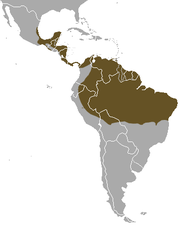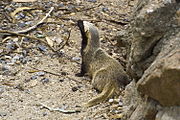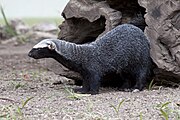| Grison | |
|---|---|

| |
| Scientific classification | |
| Domain: | Eukaryota |
| Kingdom: | Animalia |
| Phylum: | Chordata |
| Class: | Mammalia |
| Order: | Carnivora |
| Family: | Mustelidae |
| Subfamily: | Ictonychinae |
| Genus: | Galictis Bell, 1826 |
| Type species | |
| Viverra vittata | |
| Species | |

| |
| Galictis range | |
A grison (/ˈɡrɪzən/, /ˈɡraɪsən/) is any mustelid in the genus Galictis.[1] Native to Central and South America, the genus contains two extant species: the greater grison (Galictis vittata), which is found widely in South America, through Central America to southern Mexico; and the lesser grison (Galictis cuja), which is restricted to the southern half of South America.
Names
[edit]The generic name Galictis joins two Greek words: galē (γαλῆ, "weasel") and iktis (ἴκτις, marten/weasel).[2] Compare the word Galidictis (a mongoose genus).
The common name grison is from a French word for "gray", a variant of gris, also meaning "gray".[3]
Locally, in Spanish, it is referred to as a huroncito (literally "little ferret") or grisón. In Portuguese, it is a furão.[citation needed]
Description
[edit]Grisons measure up to 60 cm (24 in) in length,[4] and weigh between 1 and 3 kg (2.2 and 6.6 lb). The lesser grison is slightly smaller than the greater grison. Grisons generally resemble a honey badger, but with a smaller, thinner body. The pelage along the back is a frosted gray with black legs, throat, face, and belly. A sharp white stripe extends from the forehead to the back of the neck.
Habitat
[edit]They are found in a wide range of habitats from semi-open shrub and woodland to low-elevation forests. They are generally terrestrial, burrowing and nesting in holes in fallen trees or rock crevices, often living underground. They are omnivorous, consuming fruit and small animals (including mammals). Little is known about grison behavior for multiple reasons, including that their necks are so wide compared to their heads, an unusual difficulty that has made radio tracking problematic.[citation needed]
Evolution
[edit]Extant species
[edit]| Common name | Scientific name and subspecies | Range | Size and ecology | IUCN status and estimated population |
|---|---|---|---|---|
| Lesser grison | Galictis cuja (Molina, 1782) Four subspecies
|
Brazil, Chile, Peru, Argentina, Uruguay, and Paraguay
|
Size: Habitat: Diet: |
LC
|
| Greater grison | Galictis vittata (Schreber, 1776) Five subspecies
|
southern Mexico in the north, to central Brazil, Peru, and Bolivia in the south
|
Size: Habitat: Diet: |
LC
|
Fossils
[edit]Grisons first appeared in South America during the early Pleistocene about 2.5 million years ago. They may be descended from the fossil genera Trigonictis and Sminthosinus, which lived in North America during the mid to late Pliocene.[5] There are at least three known fossil species, all of which were found in Argentina:[4]
- † Galictis hennigi
- † Galictis sanandresensis
- † Galictis sorgentinii
References
[edit]This article includes a list of general references, but it lacks sufficient corresponding inline citations. (November 2013) |
- ^ "ZipcodeZoo - Online Encyclopedia About Plants & Animals". Archived from the original on 21 December 2014.
- ^ "Galictis". Merriam-Webster.com Dictionary. Merriam-Webster. "New Latin, from Greek galē weasel + iktis yellow-breasted marten".
Lewis and Short defines ictis (ἴκτις) simply as "a kind of weasel".[1] Archived 2013-11-02 at the Wayback Machine Brill's New Pauly likewise also notes that "ἴκτις/íktis may be a weasel"[2] - ^ "grison". Merriam-Webster.com Dictionary. Merriam-Webster. "French, from grison gray, from Middle French, from gris"
- ^ a b Yensen, E.; Tarifa, T. (2003). "Galictis vittata". Mammalian Species. 727: Number 727: pp. 1–8. doi:10.1644/727. S2CID 198121748.
- ^ Yensen, E.; Tarifa, T. (2003). "Galictis cuja". Mammalian Species. 728: Number 728: pp. 1–8. doi:10.1644/728. S2CID 198124064.
- Nowak, Ronald M. (2005). Walker's Carnivores of the World. Baltimore: Johns Hopkins Press ISBN 0-8018-8032-7








